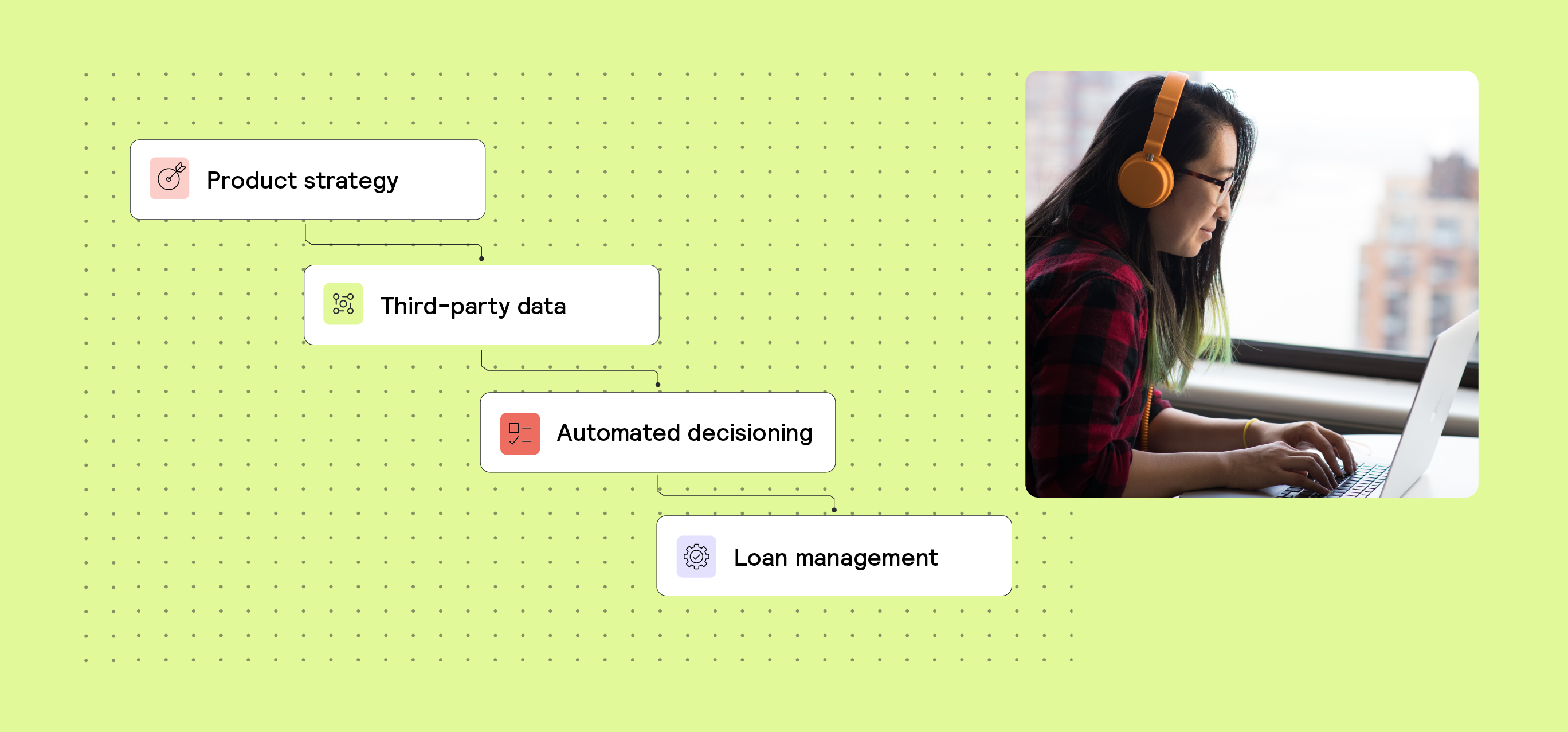AML 6 min read
Transaction monitoring for AML: 4 capabilities every system needs for smarter, scalable protection

AI deepfakes are testing even the most sophisticated risk teams. According to Fortune, a global risk manager at Ant International reported that over 70% of new enrollment attempts were fraudulent, spanning more than 150 distinct types.
This is a clear illustration of the sharp escalation of financial crime in the digital age. Money laundering, in particular, is becoming more commonplace, with examples including account takeovers, first-party fraud, and increasingly, deepfake fraud.
Now more than ever, anti-money laundering (AML) teams are at a crossroads. In this article, we break down the obstacles they face, the opportunities to modernize transaction monitoring, and the capabilities that define effective systems going forward.
Key takeaways
- Financial crime is escalating in sophistication and scale, with AI deepfakes and other advanced tactics making real-time, adaptive transaction monitoring a business-critical capability.
- Hybrid batch and real-time transaction monitoring accelerates fraud detection and analysis, enabling teams to address immediate risks while uncovering broader fraud patterns.
- AI-driven data analysis uncovers hidden patterns, reduces false positives, and enables faster, more accurate risk decisions with minimal manual effort.
- Low-code, adaptable transaction monitoring systems enable teams to update decision logic quickly and respond to evolving threats.
What is transaction monitoring in AML?
Transaction monitoring in anti-money laundering (AML) is the systematic review of customer transactions – such as deposits, withdrawals, and transfers – to identify unusual or suspicious patterns. Its purpose is to detect activity that may signal attempts to disguise illegally obtained money as legitimate funds, as well as fraud or terrorist financing.
However, with the rise of instant payments, digital banking, and global financial connectivity, criminals are constantly developing new tactics to exploit vulnerabilities. From sophisticated money-laundering schemes to coordinated AI-driven fraud rings, financial institutions face a growing wave of complex threats.
Current challenges in transaction monitoring for AML
The surge in sophisticated financial crime is exposing a critical weakness: many AML teams are still constrained by inflexible transaction monitoring systems that can’t keep pace with evolving challenges.
Tighter regulatory requirements increase risk of non-compliance
Because money laundering has become more complex and is often concealed, AML regulations are becoming increasingly stringent. The US Bank Secrecy Act, for example, mandates larger penalties for data breaches or inadequate fraud controls, making non-compliance costly for businesses. The inability to update logic quickly to meet complex regulatory requirements can put AML teams at risk of these fines.
High false positive rates erode operational efficiency
With larger volumes of transactions to process, it can become more difficult to distinguish legitimate transactions from suspicious ones, contributing to higher false positive rates. This can lead to an unmanageable amount of alerts, customer frustration, and more regulatory scrutiny – all of which can erode efficiency and lead to increased risk.
Real-time vs. batch monitoring limitations can leave threats unchecked
While real-time monitoring provides immediate defense against new threats, it can be costly and prone to false positives. Conversely, batch monitoring excels at uncovering deep, historical patterns but leaves financial institutions vulnerable to instant, escalating attacks. An inability to leverage the strengths of both types of monitoring can result in financial loss.
Resource constraints stretch AML teams thin
Regulatory pressures and outdated technology are leaving AML teams stretched thin. If resources are not allocated effectively, this can slow down operations, increase staffing costs, or drain valuable time and effort on low-value alerts rather than high-risk cases.
Ineffective monitoring can lead to customer churn and reputational damage
Finally, transaction monitoring systems that fail to protect legitimate customers can lead to church and reputational damage. In 2025, nearly 85% of consumers would switch banks if linked to financial crime, and 87% would actively warn family and friends against using that institution. The real cost isn’t only in reimbursements, but in the lifetime value and trust of your customers.
The opportunity for AI-driven transaction monitoring
As complex as these issues may seem, AI-driven innovation can become a real solution – rather than just a modern-day challenge – for institutions who can effectively harness its power.
With AI in transaction monitoring, Google Cloud decreased false positives by 60% and Mastercard analyzed 1 trillion data points in real time, according to a recent Forbes article.
This highlights a real opportunity for financial services providers: while technology is drastically reshaping the fraud landscape, it can also empower AML teams to better combat financial crime by ensuring that their transaction monitoring system is ready for the job.
4 core components of effective transaction monitoring systems for AML
To strengthen compliance, protect customers, and build trust, organizations should ensure their transaction monitoring system empowers them to:
1. Accelerate data analysis with both batch and real-time monitoring
A modern transaction monitoring system should empower teams to undertake quick, thorough data analysis to proactively prevent financial crime. By combining batch and real-time monitoring, AML teams can gain the speed needed to address immediate risks, while preserving analytical depth for lower-risk activities.
With batch monitoring, teams can automate testing on a recurring basis to process large volumes of data at once. This allows them to examine broader trends, uncover systemic fraud patterns, and generate reliable reports – all without unnecessary costs or friction.
With real-time monitoring, teams can process data continuously and provide immediate interventions for urgent threats. This minimizes data latency, enabling teams to make faster decisions in critical situations, such as a sudden, high-value deposit into a customer account.
The choice between batch and real-time monitoring is not a matter of one being superior – it depends on the specific use case. Thus, the most successful AML teams will adopt a hybrid strategy to fight fraud from all fronts.
2. Detect risk faster through AI-driven data analysis that reduces false positives and manual work
Making time-critical risk decisions is a real strategic lever, but the accuracy of those decisions – and the efficiency with which they are made – depends increasingly on AI. Traditional manual reviews and static rules can leave AML teams stretched thin, making their transaction monitoring systems prone to missed risks and excessive false positives. With limited resources, there simply isn’t enough time for analysts to monitor every transaction, nor can they reliably detect the complex patterns used by today’s fraudsters.
AI transforms this challenge by enabling faster, more precise decision-making. By analyzing diverse, high-quality data – such as user behavior, device intelligence, and geographic signals – AI models can uncover hidden patterns, reduce false positives, and assign more accurate risk scores tailored to individual profiles. This holistic approach not only strengthens fraud detection, but also ensures legitimate customers move through the system with minimal friction.
3. Adapt quickly with flexible, customizable structures that unify data and streamline rule updates
Transaction monitoring systems that rely on engineering support to create or adjust new monitoring rules can create unnecessary delays, preventing AML teams from adapting to new threats or regulatory requirements in time. Instead, modern transaction monitoring systems empower risk professionals to design, test, and update decision logic independently – without waiting for development cycles or IT backlogs.
With a flexible, low-code decision platform, teams can quickly introduce new rules to address emerging fraud typologies, tailor workflows to regional regulations, and adjust thresholds to reflect shifting customer behavior. This operational agility ensures faster responses and stronger compliance across markets.
Modern platforms can extend this flexibility further with customizable data architecture, unifying entities, events, and features into a single, dynamic system. Teams can track and analyze any relevant activity – such as logins, address changes, or new device usage – in real time, uncovering fraud attempts that might otherwise remain invisible. Custom features transform raw data into actionable signals, reducing dependence on generic risk scores and enabling faster adaptation to evolving threats.
This empowers AML teams to operate with greater autonomy and precision, building an approach to transaction monitoring that is not only compliant, but continuously optimized to meet the pace of modern financial crime.
4. Strengthen accountability through transparent, auditable histories that improve reporting and collaboration
Finally, AML teams should be able to track every change to rules and policies and maintain a clear audit trail of monitoring activities. Without this, it can become difficult to prove compliance, explain past decisions, or collaborate effectively across departments.
Modern transaction monitoring platforms solve this by automatically logging workflow changes, maintaining version histories, and creating audit-ready reports. These records not only simplify regulatory reporting, but also provide clarity when investigating escalations or reviewing historical cases.
Beyond compliance, transparency builds trust and collaboration. Risk, compliance, and operations teams gain shared visibility into decision-making processes, reducing silos and ensuring everyone is aligned. In high-stakes environments where accountability matters, a transparent, auditable history becomes both a safeguard and a catalyst for better teamwork.
Choosing a transaction monitoring solution for AML
The most effective transaction monitoring systems should enable teams to monitor time-critical transactions effectively, leverage AI for deeper data analysis, adapt logic quickly and independently, and easily report these changes to regulators and other teams.
Modern decision platforms like Taktile make this possible by giving AML teams the flexibility and intelligence they need to stay ahead of financial crime:
- Batch and real-time testing: Taktile’s Jobs feature allows teams to run continuous monitoring alongside scheduled batch analysis, ensuring both immediate interventions and deeper trend detection.
- AI-driven data analysis: Generative AI, such as Taktile’s AI Copilot, can provide summaries that help analysts uncover hidden patterns, reduce false positives, and receive clear explanations of risks with recommended next steps.
- Flexible, customizable structure: Taktile’s intuitive low-code platform empowers AML professionals to update decision logic according to real-time data analytics, without waiting for engineering support.
- Transparent, auditable history: Built-in reporting and version tracking provide audit-ready documentation and improve collaboration across teams.
While important for modern transaction monitoring, this is not an exhaustive list. Risk teams must be able to customize and evolve their transaction monitoring strategies to the unique challenges they face, achieving stronger security without compromising growth.






